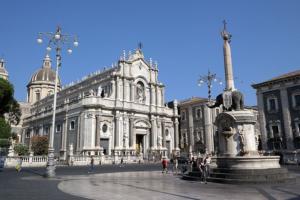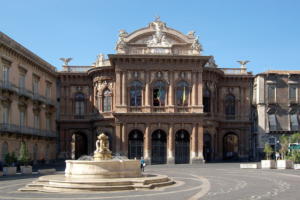
A stunning UNESCO World Heritage city centre, enchanting Baroque palaces and churches built after the tragic 17th-century eruption, one of the most vibrant cities in the Mediterranean: we’re talking about the city of Catania!
Discovering the treasures of what is often referred to as the “Black City” (due to the dark color of its buildings, which have been blackened by the soot and ashes from the imposing Mount Etna that overlooks Catania) can take at least three to four days. However, if you’re planning a short getaway to Sicily this spring, we can suggest a brief itinerary that allows you to glimpse the baroque wonders of this ancient city in just half a day.
So, get ready to wear your most comfortable shoes, and let’s get started!
Our visit begins in Piazza Federico di Svevia, where we will encounter the Ursino Castle: a Norman castle built by Emperor Frederick II of Swabia in the 13th century. The castle now houses the Civic Museum, featuring sculptures, porcelain, weapons, and paintings from the Sicilian school.
Leaving the square and walking towards Via Auteri we reach ‘A Piscaria, the famous ancient fish market of Catania, where you can buy some delicious fresh fish and a divine place to take a step into the past and the most authentic Sicilian traditions, with a touch of the allure of a magical Arab bazaar. And then, here we are, in the pedestrian area of Piazza Duomo. The buildings surrounding the square create a perfect baroque composition: Porta Uzeda, the majestic Cathedral of Sant’Agata with its marvellous façade, a beautiful example of the Sicilian baroque, Palazzo degli Elefanti, the city hall, and the black lava-stone statue of the elephant, the symbol of the city, called “U Liotru”, which dates back to Roman times and has an Egyptian obelisk on its back.
To fully enjoy Catania’s vibrant culture and stunning architecture, consider staying nearby. Discover our exclusive collection of villas, perfect for your Sicilian getaway.

We warmly invite you to visit the nearby Teatro Bellini, one of the city’s most cherished architectural treasures. Famous worldwide for its excellent acoustics and elegant design, this historic theatre, dedicated to Vincenzo Bellini, has enchanted icons like Maria Callas. A must-see experience in the heart of the city.
Suppose you’re looking for the most outstanding evidence of Sicilian Baroque architecture. In that case, you cannot miss Via dei Crociferi, extending from Villa Cerami to the Church of San Francesco d’Assisi all’Immacolata in Piazza San Francesco d’Assisi. This little alley is studded with enchanting buildings and Eighteenth-Century churches. Returning to Piazza Duomo, we suggest stopping by one of the many typical cafes to take a break and regain your strength, perhaps tasting a delicious Cannoli or a traditional Arancino. Then you can reach Palazzo Bisconti, the most important palace of Catania, a project of Alonzo di Benedetto at the behest of the Paternò Castello family, built from 1707 to 1763.
After exploring the vibrant city of Catania, discover our full collection of exclusive villas across Sicily, each offering privacy, charm, and authentic Mediterranean beauty:
FAQ About Catania
Why is Catania called the black city?
Catania often earns the nickname the Black City due to the deep, powerful shades of its historic buildings and timeless monuments. Here, every street and square seems carved from ancient memory. Lava stone shapes the city's soul—centuries-old basalt, rich and dark, gifted by Mount Etna herself. Catania showcases beauty rising from fire, with history etched into every wall, every corner, and every stone.
Walking through the historic center, particularly along Via Etnea or around Piazza del Duomo, you immediately notice how black stone shapes everything—from the majestic churches to the elegant palaces. The 1693 earthquake devastated the city, but lava stone became the primary material used in its reconstruction, giving Catania its unforgettable appearance. Catania is where nature and human creativity combine to show resilience and beauty. Here, destruction has been transformed into impressive architecture and art. Visiting Catania feels like stepping into a unique area where history, geology, and culture come together.
Thinking of exploring Catania's unique charm? Here’s what to expect:
| Pros | Cons |
|---|---|
| Unique black-lava architecture gives Catania a distinctive and memorable look. | Some visitors might find the dark tones less "bright" compared to typical Mediterranean cities. |
| Historical rebuilding after Etna's eruptions tells a story of resilience. | Buildings made of lava stone can appear a bit somber in cloudy weather. |
| Walking tours feel like open-air geology and history lessons. | In very hot summers, the dark stones absorb heat, making streets warmer. |
Is Catania in Sicily worth visiting?
Absolutely—Catania is a city you won't want to miss if you're traveling through Sicily. Nestled on the island's eastern coast, It has a mix of ancient history, vibrant city life., and the raw beauty of nature, thanks to its proximity to Mount Etna. The city center is a UNESCO World Heritage Site, renowned for its stunning Baroque buildings, which are constructed from black lava stone. This unique combination makes it a one-of-a-kind place. But Catania isn't just about the monuments—you'll also find lively street markets like La Pescheria, where you can experience real Sicilian life, taste fresh seafood, and hear the distinctive sounds of the local dialect. Add to this vibrant nightlife, a beautiful coastline, and easy access to adventures like hiking on Etna, and it's clear why Catania charms so many visitors. Catania has exciting activities for everyone. Whether you love history, enjoy food, or like to explore, there's something for you.
Planning a trip to Sicily? Here's why Catania deserves a spot on your list:
| Pros | Cons |
|---|---|
| Stunning UNESCO-listed historic center with Baroque treasures. | City traffic can be chaotic, especially in the historic core. |
| Authentic Sicilian atmosphere with vibrant markets and street life. | Some parts of the city could be perceived as less polished or "rough around the edges." |
| Perfect base for visiting Mount Etna, Taormina, and the eastern coast. | The city can be very hot and crowded during peak summer months. |
Why is Catania famous?
Catania draws you in with its fascinating history and lively culture. There's much to explore, from its stunning architecture to the vibrant atmosphere filling the streets. You can feel the city's heartbeat in its charming squares and bustling markets, making it a place alive with stories and traditions. The beautiful Baroque architecture displays its uniqueness through the craftsmanship of black volcanic stone from Mount Etna's eruptions.
This gives the city a distinctive charm that many visitors instantly recognize. Walking across the city is like traversing a live museum. Sites like Via Crociferi, the Roman Amphitheatre, and the Cathedral of Sant'Agata let you see into other eras. Catania, however, is not only about the past. The streets are bustling with people, music, and cuisine; the city is vibrant. Losing yourself in La Pescheria, Catania's old fish market, is exciting. The vibrant atmosphere has fresh seafood, lively vendors, and salty smells. It's a lively experience that captures the essence of Sicily.
Mount Etna is a beautiful sight and a vital part of the city's spirit. The volcano shapes not only the landscape but also Catania's lively culture and rich flavors. This city leaves a lasting impression on everyone who visits.
Wondering what makes Catania so iconic? Take a look:
| Pros | Cons |
|---|---|
| Rich blend of ancient Roman, medieval, and Baroque heritage. | Historical sites may require restoration in some cases. |
| Dynamic nightlife and cultural events make it lively year-round. | Noise and bustling energy might not suit travelers seeking a quiet escape. |
| Close proximity to natural wonders like Mount Etna and beautiful beaches. | Etna's activity occasionally affects travel plans with ash clouds. |
What does Catania mean in Italian?
The name "Catania" is thought to come from the ancient Greek word "Katane," which translates roughly to "grater" or "rough land." This origin likely refers to the jagged, uneven volcanic terrain created by Mount Etna, which has dominated the area's landscape for millennia. Over time, the city's relationship with the volcano has shaped not just its physical appearance but also the spirit of its people. Living so close to such a powerful natural force has fostered a culture of resilience, adaptability, and creativity. In many ways, the meaning behind Catania's name captures the essence of the city itself: rugged yet beautiful, challenging yet full of life. Even today, when you stroll through its lively streets or admire its stunning architecture, you can feel the deep connection between the city and the land it rises from—a bond that continues to define Catania's unique identity in Sicily and beyond.
Curious about the meaning behind Catania’s name? Here’s a quick breakdown:
| Pros | Cons |
|---|---|
| Name reflects a deep, authentic bond with the surrounding landscape. | The volcanic nature implies a constant, although usually minimal, risk. |
| Offers a powerful story of how nature and city life coexist harmoniously. | Volcanic terrain can sometimes make excursions more challenging. |
| Gives visitors a meaningful connection to the city’s origins and character. | Historical references might be less visible without a guided tour. |

